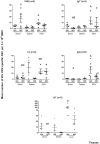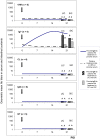Recombinant monovalent llama-derived antibody fragments (VHH) to rotavirus VP6 protect neonatal gnotobiotic piglets against human rotavirus-induced diarrhea
- PMID: 23658521
- PMCID: PMC3642062
- DOI: 10.1371/journal.ppat.1003334
Recombinant monovalent llama-derived antibody fragments (VHH) to rotavirus VP6 protect neonatal gnotobiotic piglets against human rotavirus-induced diarrhea
Abstract
Group A Rotavirus (RVA) is the leading cause of severe diarrhea in children. The aims of the present study were to determine the neutralizing activity of VP6-specific llama-derived single domain nanoantibodies (VHH nanoAbs) against different RVA strains in vitro and to evaluate the ability of G6P[1] VP6-specific llama-derived single domain nanoantibodies (VHH) to protect against human rotavirus in gnotobiotic (Gn) piglets experimentally inoculated with virulent Wa G1P[8] rotavirus. Supplementation of the daily milk diet with 3B2 VHH clone produced using a baculovirus vector expression system (final ELISA antibody -Ab- titer of 4096; virus neutralization -VN- titer of 256) for 9 days conferred full protection against rotavirus associated diarrhea and significantly reduced virus shedding. The administration of comparable levels of porcine IgG Abs only protected 4 out of 6 of the animals from human RVA diarrhea but significantly reduced virus shedding. In contrast, G6P[1]-VP6 rotavirus-specific IgY Abs purified from eggs of hyperimmunized hens failed to protect piglets against human RVA-induced diarrhea or virus shedding when administering similar quantities of Abs. The oral administration of VHH nanoAb neither interfered with the host's isotype profiles of the Ab secreting cell responses to rotavirus, nor induced detectable host Ab responses to the treatment in serum or intestinal contents. This study shows that the oral administration of rotavirus VP6-VHH nanoAb is a broadly reactive and effective treatment against rotavirus-induced diarrhea in neonatal pigs. Our findings highlight the potential value of a broad neutralizing VP6-specific VHH nanoAb as a treatment that can complement or be used as an alternative to the current strain-specific RVA vaccines. Nanobodies could also be scaled-up to develop pediatric medication or functional food like infant milk formulas that might help treat RVA diarrhea.
Conflict of interest statement
The authors have declared that no competing interests exist.
Figures






References
-
- Black RE, Cousens S, Johnson HL, Lawn JE, Rudan I, et al. (2010) Global, regional, and national causes of child mortality in 2008: a systematic analysis. Lancet 375: 1969–1987. - PubMed
-
- Parashar UD, Burton A, Lanata C, Boschi-Pinto C, Shibuya K, et al. (2009) Global mortality associated with rotavirus disease among children in 2004. J Infect Dis 200 Suppl 1: S9–S15. - PubMed
-
- Patel MM, Glass R, Desai R, Tate JE, Parashar UD (2012) Fulfilling the promise of rotavirus vaccines: how far have we come since licensure? Lancet Infect Dis 12: 561–570. - PubMed
-
- Tate JE, Burton AH, Boschi-Pinto C, Steele AD, Duque J, et al. (2012) 2008 estimate of worldwide rotavirus-associated mortality in children younger than 5 years before the introduction of universal rotavirus vaccination programmes: a systematic review and meta-analysis. Lancet Infect Dis 12: 136–141. - PubMed
Publication types
MeSH terms
Substances
Grants and funding
LinkOut - more resources
Full Text Sources
Other Literature Sources
Medical

